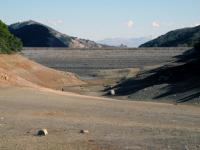-
Even if the Paris Agreement is implemented, food and water supplies remain at risk
If all pledges made in last December’s Paris climate agreement (COP21) to curb greenhouse gases are carried out to the end of the century, then risks still remain for staple crops in major “breadbasket” regions and water supplies upon which most of the world’s population depend. Recognizing that national commitments made in Paris to reduce greenhouse gas emissions fall far short of COP21’s overarching climate target — to limit the rise, since preindustrial times, in the Earth’s mean surface temperature to 2 degrees Celsius by 2100 — a new report advances a set of emissions scenarios that are consistent with achieving that goal.
-
-
New $4 million facility at UW to investigate natural disasters worldwide
A new Post-Disaster, Rapid Response Research Facility at the University of Washington will provide necessary instrumentation and tools to collect and assess critical post-disaster data, with the goal of reducing physical damage and socio-economic losses from future events. The NSF’s $40 million NHERI investment, announced in September 2015, funds a network of shared research centers and resources at various universities across the nation. The goal is to reduce the vulnerability of buildings, tunnels, waterways, communication networks, energy systems, and social groups in order to increase the disaster resilience of communities across the United States.
-
-
Strengthening U.S. infrastructure to withstand disasters
The delivery of essential services — whether in food, water, health, or emergency response — relies increasingly upon a complex, interconnected system of critical infrastructure. Ensuring these interdependent systems continue to operate during disasters and other disruptive events is crucial to maintaining public health and safety. NSF announces $22.7 million in new investments to promote better understanding and functioning of these infrastructures in an effort to improve their resilience.
-
-
Megadrought lasting three decades likely for Southwest U.S., Midwest

The consequences of climate change paint a bleak picture for the Southwest and much of America’s breadbasket, the Great Plains. The role of climate change in causing extreme heat waves, drastic rainfall, negative impacts on human health, and threatened food security have received more attention recently than megadrought, but scientists view prolonged drought risk as yet another natural hazard that becomes more likely from human activity.
-
-
New technology pinpoints water contamination sources

When the local water management agency closes your favorite beach due to unhealthy water quality, how reliable are the tests they base their decisions on? As it turns out, those tests, as well as the standards behind them, have not been updated in decades. Now scientists have developed a highly accurate, DNA-based method to detect and distinguish sources of microbial contamination in water.
-
-
Florida tightens public notification rules for pollution incidents
Last week Governor Rick Scott instructed Florida Department of Environmental Protection (DEP) Secretary Jon Steverson to issue an emergency rule that establishes new requirements for public notification of pollution incidents. The rule is to take effect immediately. Scott issued the instruction following the sewage spill in Pinellas County and the sinkhole at Mosaic’s New Wales facility.
-
-
Massive 2014 West Virginia chemical spill was preventable: CSB
The Chemical Safety Board’s (CSB) final report into the massive 2014 release by Freedom Industries of chemicals into the primary source of drinking water of Charleston, West Virginia, concludes that Freedom Industries failed to inspect or repair corroding tanks, and that as hazardous chemicals flowed into the Elk River, the water company and local authorities were unable effectively to communicate the looming risks to hundreds of thousands of affected residents, who were left without clean water for drinking, cooking, and bathing.
-
-
California's almond boom ramped up water use, consumed wetlands
Converting land in California to grow water-hungry almonds between 2007 and 2014 has led to a 27 percent annual increase in irrigation demands — despite the state’s historic drought. The expansion of almonds has also consumed 16,000 acres of wetlands and will likely put additional pressure on already stressed honeybee populations.
-
-
Insights on Deepwater Horizon disaster
The soon-to-be-released thriller “Deepwater Horizon,” which opens in theaters 30 September, promises moviegoers a chilling reenactment of one of history’s worst oil rig disasters. One scholar of societal collapse will enter the theater with a big-picture view of the perfect storm of factors that led to the explosion and oil spill that killed eleven people and sent more than 200 million gallons of crude oil spewing toward the nation’s southern coastline for eighty-seven days.
-
-
Abnormalities found in drinking water in Texas’s Eagle Ford Shale region
Chemists studying well water quality in the Texas’s Eagle Ford Shale region found some abnormal chloride/bromide ratios, alongside evidence of dissolved gases and sporadic episodes of volatile organic compounds, all indicative of some contamination from industrial or agricultural activities in the area.
-
-
Radioactive wastewater enters Florida major aquifer after huge sinkhole opens up below fertilizer plant
At least 980 million liters of highly contaminated water — including radioactive substances – has leaked into one of Florida’s largest sources of drinking water. The leak was caused by a huge sinkhole which opened up beneath a fertilizer plant near Tampa. The sinkhole caused highly contaminated waste water to pass into an aquifer which supplies much of the state. The waste water contained phosphogypsum, a by-product of fertilizer production, which contains naturally occurring uranium and radium. the Floridan aquifer aquifer underlies all of Florida and extends into southern Alabama, Georgia, and South Carolina, supplying groundwater to the cities of Tallahassee, Jacksonville, Gainesville, Orlando, Daytona Beach, Tampa, and St Petersburg.
-
-
Solar-powered Ring Garden combines desalination, agriculture for drought-stricken California
With roughly 80 percent of California’s already-scarce water supply going to agriculture, it is crucial for the state to embrace new technologies that shrink the amount of water required to grow food. Alexandru Predonu has designed an elegant solution which uses solar energy to power a rotating desalination plant and farm that not only produces clean drinking water for the city of Santa Monica, but also food crops — including algae.
-
-
Solar-powered Pipe desalinizes 1.5 billion gallons of drinking water for California
The infrastructure California needs to generate energy for electricity and clean water, which will be significant, need not blight the landscape. Designs like The Pipe demonstrate how the provision of public services like these can be knitted into every day life in a healthy, aesthetically pleasing way.
-
-
New cooling method for large data centers to save millions of gallons of water
In different parts of the country, people discuss gray-water recycling and rainwater capture to minimize the millions of gallons of groundwater required to cool large data centers. But the simple answer in many climates is to use liquid refrigerant. A cooling system – if installed next year at Sandia National Laboratories computing center – is expected to save 4 million to 5 million gallons annually in New Mexico, and hundreds of millions of gallons nationally if the method is widely adopted.
-
-
Water pollution across three continents poses health risks to hundreds of millions
Water pollution has risen across three continents, placing hundreds of millions of people at risk of contracting life-threatening diseases like cholera and typhoid. Pathogen and organic pollution rise in more than 50 percent of river stretches in Africa, Asia, and Latin America. Asia hit hardest by rise in severe pathogen pollution, with up to a half of all river stretches affected. Up to 323 million people on three continents at risk of infection from diseases caused by pathogens in water.
-
More headlines
The long view
Water Wars: A Historic Agreement Between Mexico and US Is Ramping Up Border Tension
As climate change drives rising temperatures and changes in rainfall, Mexico and the US are in the middle of a conflict over water, putting an additional strain on their relationship. Partly due to constant droughts, Mexico has struggled to maintain its water deliveries for much of the last 25 years, deliveries to which it is obligated by a 1944 water-sharing agreement between the two countries.
